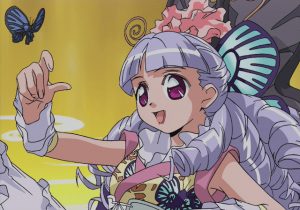If you haven’t played an Idol Janshi game before, which is probably most people, let’s review how these games work. First, you pick which of the female characters you want to play as. Next, you play one-on-one mahjong with special abilities, like being able to see your opponent’s hand or influencing the tiles you draw. When you win a hand, the number of han points in your hand turns into “panel points” for the panel flipping game. Flipping over matching tiles will earn you power-ups and other goodies that vary from game to game. If you manage to flip over all the panels, your opponent is automatically defeated. Depending on the game, you may get to see some number of lewd drawings. Repeat this process until you beat the final boss, then… That’s it. Congratulations. A playthrough, depending on your skill level, should take between 90 minutes and 2 hours, and there’s really no reason to play the game again.

At least, that’s how Idol Janshi is, but this is Idol Janshi R. The game follows the same basic beats as the old games, but now there’s (seemingly) hours of fully-voiced cut scenes, a light powdering of

So is this a good game? Is it worth the effort of tracking down a copy and importing it? I’m gonna have to go with ‘no’.
The biggest issue I have with the game is just the fact that its 2-player mahjong in 2002. These head-to-head mahjong games simply have no place beyond the Super Famicom or maybe Sega Saturn era. Even the Famicom was able to handle 4-player mahjong with 4人打ち麻雀. I get that 2-player is part of the series’ DNA, but R was the perfect time to split from that tired formula.
When it comes to gameplay, the only thing really new here is the unlock system. As you play, you accumulate points that can be spent at a shop, unlocking new tiles to play with and… well, I’m honestly not really sure what else. There’s several pages of items to buy (some of which are still locked after multiple playthroughs), and I haven’t been able to tell what they do. Granted, that’s on me and my inability to effectively read Japanese, but so far there hasn’t been anything compelling to do with the unlock system.
The graphics and overall presentation are, on the whole, quite nice. In-game there’s nothing that breaks the mold; everything new and interesting happens between the matches. Jaleco PCCW Japan was really trying to make something that would create virtual idols, like Hatsune Miku that would take over Japan five years later. Unfortunately, this would be the only release in the series, and potentially the last release of any Idol Janshi game period.
If you see a copy floating around eBay for $15 or $20, it might be worth it if there’s something about the game that piques your interest. If you’re dead-set on getting a 2-player mahjong game for the PlayStation 2, the Ten and Akagi games are not only easier to find and less expensive, but also much more interesting.
I’ve also posted scans, photos, and other information about the game in this post over here.









